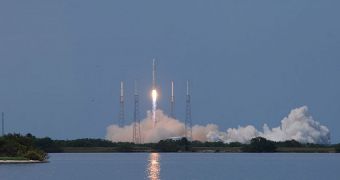At 2:45 pm EDT (1845 GMT) yesterday, June 5, Space Exploration Technologies (SpaceX) Corporation made history, when it launched its commercial Falcon 9 delivery system. After months of glitches, delays and waiting for approvals, engineers at the Hawthorne, California-based company were able to send the rocket into space, on a low-Earth orbit (LEO) some 250 kilometers, or 155 miles, above the surface. The medium-lift spacecraft took off from its designated launch pad, at the Cape Canaveral Air Force Station (CCAFS) in Florida, Space reports.
With its launch, a new era is dawning, that of privately-owned, commercially-available space vehicles, which could conceivably be used for a variety of applications, such as launching satellites and cargo to space and the International Space Station, and even delivering astronauts to the orbital facility. This is not the first rocket SpaceX launches, as it has registered success with its Falcon 1 delivery system as well. But the Falcon 9 was designed specifically to carry the Dragon space capsule. This component can dock to the ISS, but it can also be converted to transport astronauts.
“We got our Falcon 9 rocket to orbit. It achieved a near bull's eye,” said immediately after the launch PayPal co-founder and SpaceX CEO Elon Musk. Only a minor glitch was found during launch, when a video camera aboard the rocket showed the vehicle performing a slight roll while in mid-flight. But Musk said that the unplanned maneuver had no influence on the final outcome of the flight. The take-off time was originally planned for 1 am EDT (1500 GMT), but a ship was found in the waters of the safe zone around the seaside CCAFS. At 1:30 pm EDT (1730 GMT), another launch attempt was stopped by a glitch that triggered a failsafe mechanism.
The successful take-off is “a huge milestone achievement for SpaceX as a company, because they've invested a lot of time, a lot of money, a lot of engineering, and to get to an actual flight test is definitely an impressive achievement,” say the Commercial Spaceflight Federation President Brett Alexander. The CSF is a group that represents private companies involved in the aerospace exploration industry. His enthusiasm is triggered by the seamless fashion in which the rocket blasted off on its second attempt. All systems on the 178-foot (54-meter). Liquid-fueled rocket functioned within optimal parameters.
“If [the test launch] is successful I think it's symbolically the new age, because it's the first time to orbit by a vehicle being built entirely by a private corporation. It is a game changer in that sense. It makes the commercial space stuff finally credible. What people have been saying in Congress is the commercial sector can't do it. I think in the larger congressional community there will be less willingness to say, 'Oh yeah, we need to keep the shuttle flying, keep Constellation going.' I think they'll be more willing to back the President,” said before the test University of Central Florida space policy expert Roger Handberg, speaking about the challenges still ahead for space exploration.

 14 DAY TRIAL //
14 DAY TRIAL //